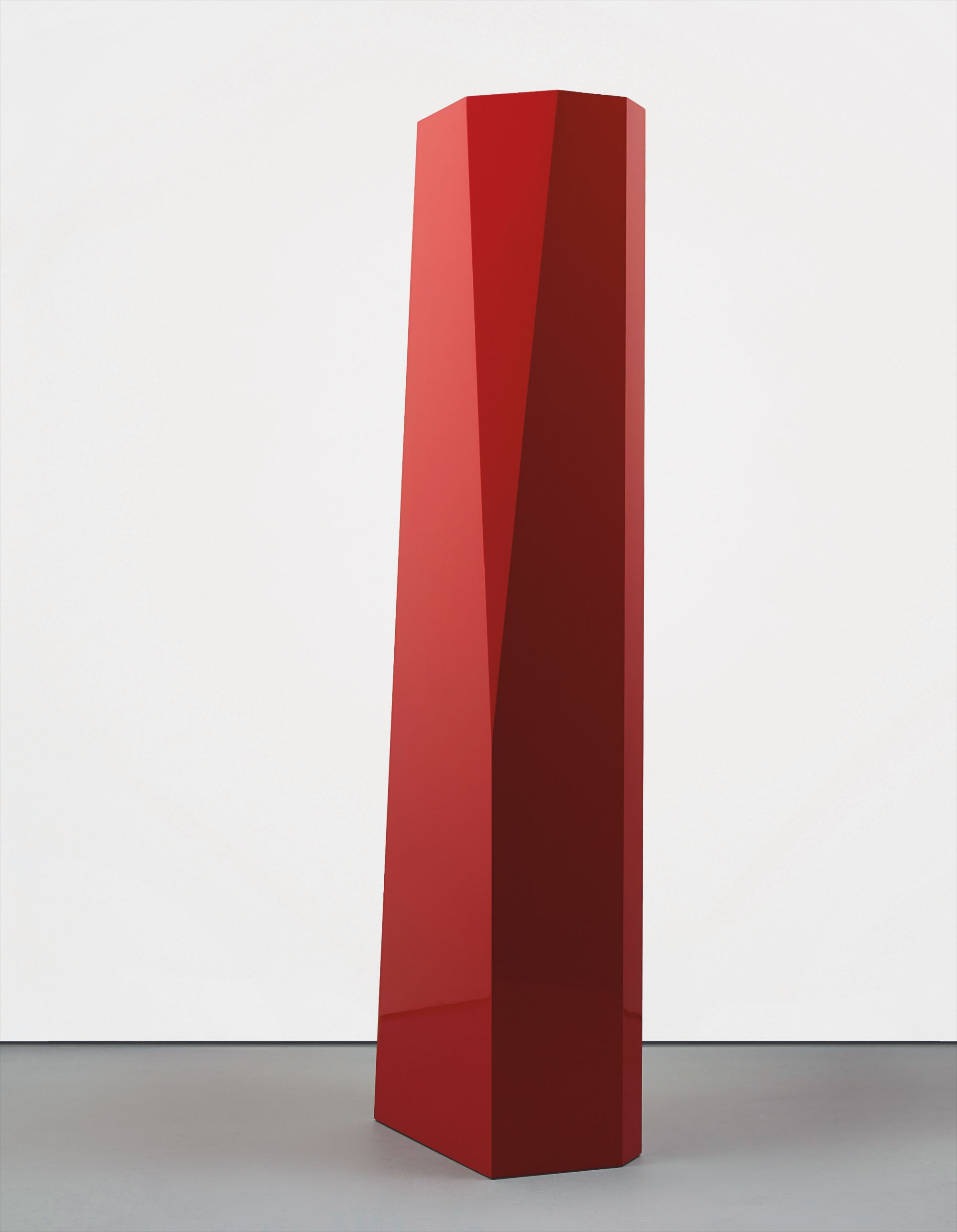

136
John McCracken
Chieftain
signed, titled and dated "CHIEFTAIN 1992 J. McCracken" on the underside
lacquer, resin, fiberglass and plywood
96 1/8 x 29 7/8 x 17 in. (244.2 x 75.8 x 43.3 cm.)
Executed in 1992.
Full-Cataloguing
“I wanted to make something as simple as possible and have it still retain or have – being an interest and so forth – you know, not dumb but smart, so to speak, or with being” –John McCracken
Within the circle of West Coast Minimalists, John McCracken developed a singular object-based aesthetic. Throughout his prolific practice, McCracken has erected works that uniquely occupy the realms of both painting and sculpture. While he began his career as a painter, in the 1960s, he began making sculptures, ranging from his signature planks to freestanding geometric forms. These objects, mostly made of fiberglass and often painted with a glossy lacquer, lean against walls and stand freely on gallery floors, interacting with the spaces they occupy, with both the floor and wall simultaneously. As the artist himself says, these sculptures exist “between two worlds, the floor representing the physical world of standing objects, trees, car, buildings, human bodies…and the wall representing the world of the imagination, illusionist painting space, [and] human mental space.” (John McCracken, quoted in Thomas Kellein, “Interview with John McCracken. August 1995”, exh. cat., Kunsthalle Basel, 1995, pp. 21-39, p. 32). McCracken always considered the scale of his viewer when building his sculptures, always making them, as he describes, “big enough to be in a space with humans” but “not to be shocking or not to be too bloated” (John McCracken, quoted in Judith Olch Richards, “Oral history interview with John McCracken”, April 19 and August 4, 2010, online).
Painted in fiery red, the present lot is a beautiful example of McCracken’s free-standing forms, entitled Chieftain. In its lustrous qualities, it recalls the California car culture from which the artist drew his inspiration for the surface of these objects. On the floor, it stands out like a sleek red Cadillac on a winding road. In this sense, the pillar evokes a sense of familiarity, yet in its reduction to simple geometric and monochromatic three-dimensionality, it invites a variety of interpretations in its universality. Depending on the angle from which it is viewed, the sculpture’s shades of red vary across the reflective surface, allowing the viewer to see themselves in its polygonic sides. In both surface and shape, Chieftain recalls the same qualities of Donald Judd’s geometric constructed objects, yet in the way that it stands on its own, like just another human figure occupying a room, McCracken’s sculpture seems even more democratic. At once minimalist and complex, Chieftain is a paradigm in McCracken’s oeuvre of sensual, lustrous objects.
Within the circle of West Coast Minimalists, John McCracken developed a singular object-based aesthetic. Throughout his prolific practice, McCracken has erected works that uniquely occupy the realms of both painting and sculpture. While he began his career as a painter, in the 1960s, he began making sculptures, ranging from his signature planks to freestanding geometric forms. These objects, mostly made of fiberglass and often painted with a glossy lacquer, lean against walls and stand freely on gallery floors, interacting with the spaces they occupy, with both the floor and wall simultaneously. As the artist himself says, these sculptures exist “between two worlds, the floor representing the physical world of standing objects, trees, car, buildings, human bodies…and the wall representing the world of the imagination, illusionist painting space, [and] human mental space.” (John McCracken, quoted in Thomas Kellein, “Interview with John McCracken. August 1995”, exh. cat., Kunsthalle Basel, 1995, pp. 21-39, p. 32). McCracken always considered the scale of his viewer when building his sculptures, always making them, as he describes, “big enough to be in a space with humans” but “not to be shocking or not to be too bloated” (John McCracken, quoted in Judith Olch Richards, “Oral history interview with John McCracken”, April 19 and August 4, 2010, online).
Painted in fiery red, the present lot is a beautiful example of McCracken’s free-standing forms, entitled Chieftain. In its lustrous qualities, it recalls the California car culture from which the artist drew his inspiration for the surface of these objects. On the floor, it stands out like a sleek red Cadillac on a winding road. In this sense, the pillar evokes a sense of familiarity, yet in its reduction to simple geometric and monochromatic three-dimensionality, it invites a variety of interpretations in its universality. Depending on the angle from which it is viewed, the sculpture’s shades of red vary across the reflective surface, allowing the viewer to see themselves in its polygonic sides. In both surface and shape, Chieftain recalls the same qualities of Donald Judd’s geometric constructed objects, yet in the way that it stands on its own, like just another human figure occupying a room, McCracken’s sculpture seems even more democratic. At once minimalist and complex, Chieftain is a paradigm in McCracken’s oeuvre of sensual, lustrous objects.